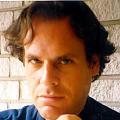
You Killed Me First, installation view, 1985.
James Romberger – artist, gallerist, writer and collaborator with David Wojnarowicz during the salad days of the East Village – was prompted by the current censorship of “A Fire In My Belly” to pen an eloquent analysis and remembrance of his friend. Wojnarowicz’s Apostasy http://www.tcj.com/hoodedutilitarian/2010/12/wojnarowiczs-apostacy/ is an essential read.
Romberger’s central thesis:
David’s oeuvre was never only about his reactions to organized religion, nor was it ever only about the AIDS crisis. Certainly the disease that would kill him in 1992 gave his work a powerful impetus, but David always took a greater global view. He examined the way that the natural world works and how our relationships with each other and the planet fit within the continually shifting narrative of history. He also expressed a complex interiority as he engaged with different media to make his sometimes lyrical, sometimes enraged or explicit, but always thoughtful and heartfelt art.
David took on heroic proportions because of his outspoken response to the AIDS epidemic. He watched his friends falling around him. After his own diagnosis in 1988, he made a concerted effort to understand the disease and to combat the people and institutions that he was able to identify as enablers of the virus through their homophobia and suppression of information…
But even earlier, in 1986 and 1987 as he watched his mentor, the photographer Peter Hujar, waste away and die, David believed the Roman Catholic Church had abandoned everyone he loved…
The imagery of Catholicism suffused his work from the beginning. David’s friend and my partner, the interdisciplinary artist Marguerite Van Cook says he had “a crisis of faith,” certainly his beliefs were sorely tested…
A Fire in My Belly has been defended as being about AIDS and not about his anger towards the Church, but David’s later motivations should not be retrospectively applied to a film that he made earlier. The Smithsonian has posted a “Q&A” on their website which claims, “This imagery was part of a surrealistic video collage filmed in Mexico expressing the suffering, marginalization and physical decay of those who were afflicted with AIDS.” However, what is being shown on Youtube and elsewhere online is not the original film, its intent has been changed because elements have been added that are misplaced in time. The versions in circulation now both have imposed soundtracks and their meaning is altered with added imagery that was made years later. David made A Fire in My Belly in 1986, before he was diagnosed with AIDS.

Street Kid, acrylic and collage, 1986.
Romberger goes on to describe a jarring private screening of an early edit of the Mexican footage that would become “A Fire In My Belly”
What followed was an assault on my senses, a view of a world completely out of control. The strobed, often violent scenes of wrestlers, cock and bull fights, lurid icons, impoverished dwellings, clanking engines, an enslaved monkey, cripples begging for coins, for bread, a burning, spinning globe—it was a picture of indifference to the value of life, Mexico as a grinding machine of poverty and cruel spectacle.
and also several installations produced with Wojnarowicz at the infamous Ground Zero project space on East Fourth Street. All fascinating reading, revelatory of the artistic process, and a window back to another era of the East Village. But most of all, a necessary corrective to much of the recent misconstrued gloss on Wojnarowicz produced in the wake of the censorship crisis.

Portrait of Bishop Landa. Mixed media, 1986.
I posted the following to Romberger after reading his text, which I again urge you to read in its entirety:
James, this is the most truthful, informed and sincere text I have read on David and on “A Fire In My Belly” since the whole censorship mess began. Congratulations. I myself have covered the controversy several times on my post.thing.net blog, but never from the “inside”. You and Marguerite were privileged to collaborate with David while he was still alive, and your insights benefit from this working relationship.
Many of the pieces I have read recently suffer rather than benefit from hindsight. However well intentioned, they tend to limit David to his AIDS activism, to make him an ACT UP poster boy. Thanks for presenting the total picture. While there is no denying the effect of the epidemic in galvanizing David’s attention, sharpening his acerbity and crystallizing his imagery, his “complex interiority” was already well formed before AIDS became an unavoidable presence in his life. The Mexican imagery which forms the basis of “Fire In My Belly” is informed by a love/hate relationship with his native Catholicism, with the Church’s betrayal and hypocrisy, with the “crisis of faith” you perceptively examine above.
The forces of repression and reaction might think they have won a round in the culture wars. But ironically, the unintentional effect of the censorship has been to focus a belated and long overdue reassessment of Wojnarowicz’s life and work. Your article is an essential part of this effort.

Mexican Crucifix, acrylic and collage on panel, 1986.

